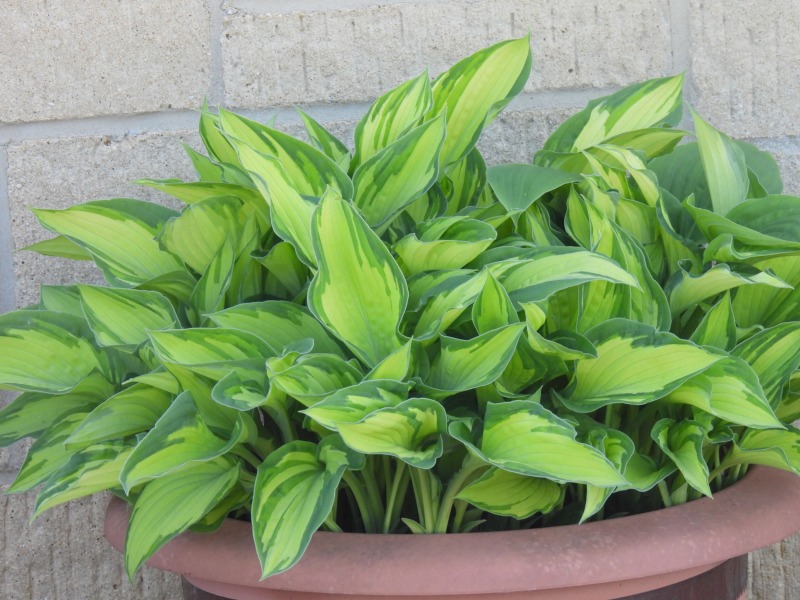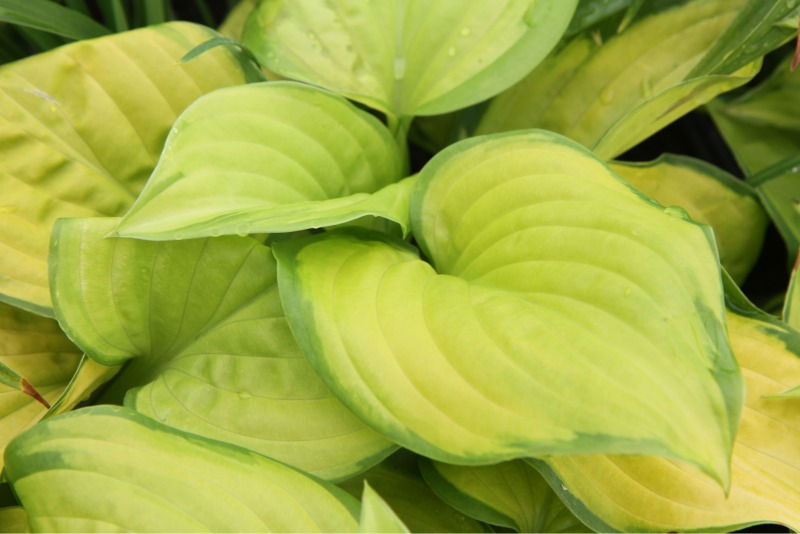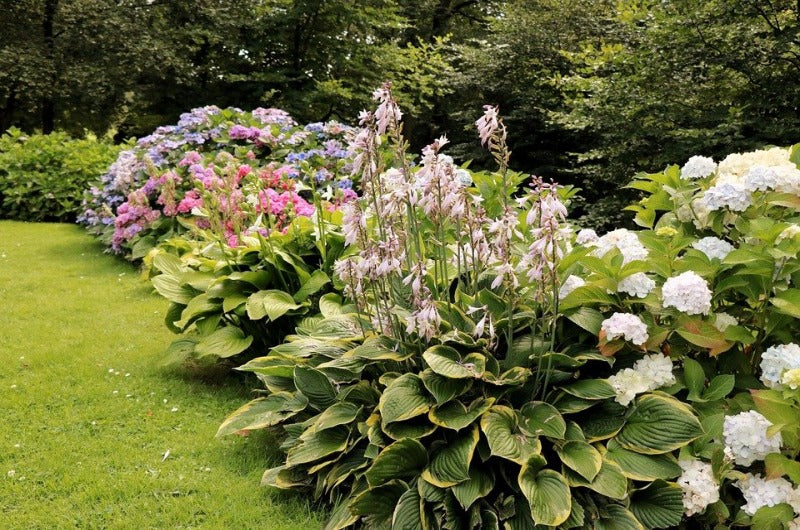The ribbed leaves of Hosta ‘August Moon’ glow with golden-green light this morning, their lavender bells quivering high above the sea of foliage.
In a lush, shady corner of my garden, under an overhanging Acer, Hostas provide attractive ground cover and their tall flower spikes create structure in early summer.

Hostages bravely awaiting their fate
Hostas in the Garden
Blue-hued Hostas create a lovely understorey for purple and pink herbaceous perennials such as Astrantia major or Geranium phaeum ‘Samobor’. Golden perennials like Trollius x cultorum ‘Alabaster’ and Digitalis grandiflora blend beautifully with variegated creamy-yellow Hosta ‘Great Expectations’ and Hosta ‘Wide Brim’. Variegated white Hostas like Hosta ‘Patriot’ and Hosta ‘Francee’ create a cool elegance, especially when combined with white-flowered perennials such as Astrantia major ‘Shaggy’ or Geranium macrorrhizum ‘White-Ness’.
Traditionally planted in woodland borders which mimic their natural habitat, Hostas pair well with the contrasting dissected foliage of Soft Shield Fern (Polystichum setiferum) and Broad Buckler Fern (Dryopteris dilatata). They also look magnificent planted under maples like my Acer palmatum dissectum ‘Crimson Queen’ and combined with elegant, shade-tolerant grasses like Japanese Forest Grass (Hakonechloa macra).
The dramatic leaves work well in tropical-style planting schemes beneath the lofty foliage of Hardy Banana (Musa basjoo), the Castor Oil Plant (Ricinus communis) and the inky leaves of Colocasia esculenta ‘Black Magic’. Adding hot highlights with orange Crocosmia and Canna ‘Tropicana’, fiery cascading Spanish Flag (Ipomoea lobata), Ginger lilies (Hedychium) and brilliant Dahlias like ‘Bishop’s Children’ brings a tropical border to life.
Hostas make superb specimen plants in containers. Different colours and sizes can be grouped together to create a striking display, or the same cultivar repeated to lead the eye along a path in a formal garden. Plant in peat-free compost in large pots with drainage holes and ensure that compost remains moist throughout the summer. My Hostas thrive in pots on the patio, and I’m always excited when I see fresh foliage unfurling in spring, knowing what vast potential there is in those tight green rolls of leaf.
Growing Hostas
These denizens of dappled shade prefer moist soils. Variegated or yellow-leaved cultivars like Hosta ‘Guacamole’ will flourish in slightly sunnier positions, as long as you dig in plenty of organic matter when planting to lock in that vital moisture. Plant 90cm apart in a hole the same depth as the root ball but a little wider. Water well in the first year, and apply mulch in spring after a heavy rain.

Fresh Guacamole is a sign of a great host
Slug Protection
Hostas have a reputation for being the plant of choice for slugs and snails. It is best to avoid using Metaldehyde slug pellets, which are harmful to wildlife and pets. In a recent RHS study, organic slug pellets were found to be more effective than non-organic pellets at controlling slug damage on Hostas, and although less effective, they caused noticeably less damage to the plants than dynamite, so they are an ideal alternative to both.
I find physical control particularly effective, especially sticking broad copper tape or mesh around the outer rim of pots. The copper barrier gives slugs and snails a shock if they touch it, but it must be wide enough to stop the big ones from charging through the discomfort – 2 inches / 5cm wide seems to be enough to stop 90% of them. Beer traps are also good, but you have to maintain them whenever they dry out or take in rainwater, and you need plenty of them to give your border serious protection.

A host of hostas in flower
Other Broad-leaved Choices
If slugs are really rampant in your garden, these perennials are less appealing to them, have eye-catching, architectural foliage, and also thrive in shady areas. One of my favourites, Lungwort (Pulmonaria), has attractive mottled foliage with blue or red flowers in spring; the heart-shaped leaves of Brunnera macrophylla are even more majestic. My favourites include softly-variegated cultivars like ‘Hadspen Cream’ and silvery-leaved ‘Alexander’s Great’. Both add lightness and sparkle to darker areas of the garden.
Bergenia are usually grouped with spring-interest plants due to their flowering period, but their foliage looks fabulous throughout the summer too. Try drought-tolerant B. ‘Ice Queen’ or B. ‘Overture’ with its deep green leaves that turn a rich burgundy after the first cold snap in winter. Heucheras and Tiarellas are fantastic shade-loving plants with vivid foliage that adds interest to dark, shady areas. I love deep purple Heucheras like ‘Purple Palace’ and ‘Grape Timeless’, the vibrant orange foliage of ‘Marmalade’ and the zingy limes of ‘Sweet Tart’ and ‘Dizzi Blonde’.
Written by: Nic Wilson
